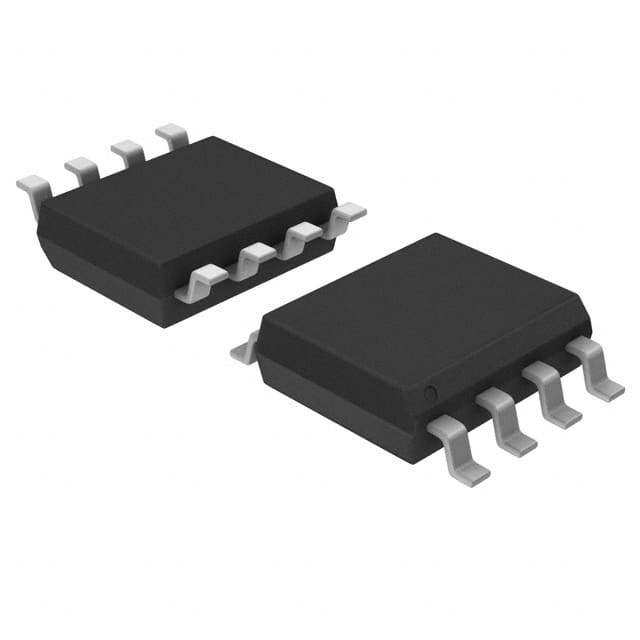Viz Specifikace pro podrobnosti o produktu.

24LC1025T-I/SN
Product Overview
Category
The 24LC1025T-I/SN belongs to the category of electrically erasable programmable read-only memory (EEPROM) chips.
Use
This product is commonly used for non-volatile data storage in various electronic devices, such as microcontrollers, computers, and consumer electronics.
Characteristics
- Non-volatile: The stored data remains even when power is removed.
- Electrically erasable: The data can be erased and reprogrammed electronically.
- High storage capacity: The 24LC1025T-I/SN has a capacity of 1,048,576 bits (128 kilobytes).
- Low power consumption: It operates at low voltage levels, making it suitable for battery-powered devices.
- I2C interface: The chip communicates using the widely-used I2C protocol.
Package
The 24LC1025T-I/SN is available in a small outline integrated circuit (SOIC) package. This package provides a compact form factor and ease of integration into various electronic systems.
Essence
The essence of the 24LC1025T-I/SN lies in its ability to store and retrieve data reliably, even in the absence of power. Its high capacity and low power consumption make it an ideal choice for applications requiring non-volatile memory.
Packaging/Quantity
The 24LC1025T-I/SN is typically sold in reels or tubes, with each reel or tube containing a specific quantity of chips. The exact packaging and quantity may vary depending on the supplier.
Specifications
- Memory Capacity: 1,048,576 bits (128 kilobytes)
- Supply Voltage: 1.7V to 5.5V
- Operating Temperature Range: -40°C to +85°C
- Data Retention: Up to 200 years
- Write Endurance: 1,000,000 cycles
Detailed Pin Configuration
The 24LC1025T-I/SN has a total of 8 pins, each serving a specific function:
- VCC: Power supply input
- SDA: Serial data input/output for I2C communication
- SCL: Serial clock input for I2C communication
- A0: Address bit 0 (used for device addressing)
- A1: Address bit 1 (used for device addressing)
- A2: Address bit 2 (used for device addressing)
- WP: Write protect pin (optional, used to prevent accidental writes)
- GND: Ground reference
Functional Features
- Random access: Allows reading and writing of individual memory locations.
- Byte-level operations: Supports byte-level read and write operations.
- Page write mode: Enables faster writes by allowing multiple bytes to be written in a single operation.
- Software write protection: The WP pin can be used to protect the memory from accidental writes.
Advantages and Disadvantages
Advantages
- High storage capacity for a wide range of applications.
- Low power consumption, making it suitable for battery-powered devices.
- Reliable data retention for extended periods.
- Compact form factor for easy integration into electronic systems.
- Compatibility with the widely-used I2C interface.
Disadvantages
- Limited write endurance compared to other non-volatile memory technologies.
- Slower write speed compared to some other memory types.
- Relatively higher cost per bit compared to certain alternatives.
Working Principles
The 24LC1025T-I/SN utilizes electrically erasable programmable read-only memory (EEPROM) technology. It consists of a grid of memory cells that can be individually programmed or erased using electrical signals. The stored data is retained even when power is removed, thanks to the non-volatile nature of EEPROM.
The chip communicates with the host microcontroller or system using the I2C protocol. This allows for easy integration and control of the memory operations.
Detailed Application Field Plans
The 24LC1025T-I/SN finds applications in various fields, including:
- Embedded Systems: Used for storing configuration data, firmware updates, and user settings in microcontrollers and embedded systems.
- Industrial Automation: Enables data logging, parameter storage, and device configuration in industrial automation equipment.
- Consumer Electronics: Used in devices such as smart TVs, set-top boxes, and gaming consoles for storing user preferences, channel lists, and other data.
- Automotive Electronics: Enables storage of critical data, such as calibration values, sensor readings, and vehicle settings in automotive electronic control units (ECUs).
- Medical Devices: Used for storing patient data, device configurations, and firmware updates in medical devices like patient monitors and infusion pumps.
Detailed and Complete Alternative Models
- 24LC512: A lower capacity variant with 512 kilobits (64 kil
Seznam 10 běžných otázek a odpovědí souvisejících s aplikací 24LC1025T-I/SN v technických řešeních
What is the maximum clock frequency for 24LC1025T-I/SN?
- The maximum clock frequency for 24LC1025T-I/SN is 400 kHz.What is the operating voltage range for 24LC1025T-I/SN?
- The operating voltage range for 24LC1025T-I/SN is 1.7V to 5.5V.Can 24LC1025T-I/SN be used in automotive applications?
- Yes, 24LC1025T-I/SN is AEC-Q100 qualified and suitable for automotive applications.What is the typical write cycle time for 24LC1025T-I/SN?
- The typical write cycle time for 24LC1025T-I/SN is 5 ms.Is 24LC1025T-I/SN compatible with I2C protocol?
- Yes, 24LC1025T-I/SN is compatible with I2C protocol.What is the temperature range for 24LC1025T-I/SN?
- The temperature range for 24LC1025T-I/SN is -40°C to +125°C.Can 24LC1025T-I/SN be used in industrial control systems?
- Yes, 24LC1025T-I/SN is suitable for use in industrial control systems.What is the maximum data transfer rate for 24LC1025T-I/SN?
- The maximum data transfer rate for 24LC1025T-I/SN is 100 kHz at 1.7V and 400 kHz at 5.5V.Does 24LC1025T-I/SN have built-in write protection?
- Yes, 24LC1025T-I/SN features a built-in hardware write protection.Is 24LC1025T-I/SN RoHS compliant?
- Yes, 24LC1025T-I/SN is RoHS compliant.

